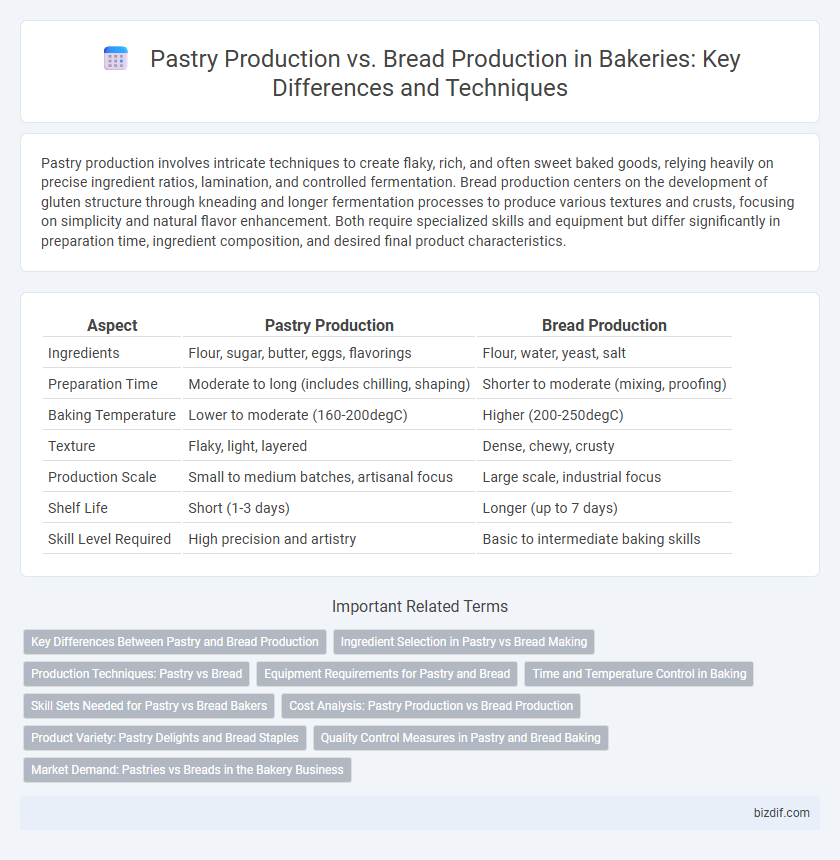Pastry production involves intricate techniques to create flaky, rich, and often sweet baked goods, relying heavily on precise ingredient ratios, lamination, and controlled fermentation. Bread production centers on the development of gluten structure through kneading and longer fermentation processes to produce various textures and crusts, focusing on simplicity and natural flavor enhancement. Both require specialized skills and equipment but differ significantly in preparation time, ingredient composition, and desired final product characteristics.
Table of Comparison
| Aspect | Pastry Production | Bread Production |
|---|---|---|
| Ingredients | Flour, sugar, butter, eggs, flavorings | Flour, water, yeast, salt |
| Preparation Time | Moderate to long (includes chilling, shaping) | Shorter to moderate (mixing, proofing) |
| Baking Temperature | Lower to moderate (160-200degC) | Higher (200-250degC) |
| Texture | Flaky, light, layered | Dense, chewy, crusty |
| Production Scale | Small to medium batches, artisanal focus | Large scale, industrial focus |
| Shelf Life | Short (1-3 days) | Longer (up to 7 days) |
| Skill Level Required | High precision and artistry | Basic to intermediate baking skills |
Key Differences Between Pastry and Bread Production
Pastry production involves using higher fat content, such as butter and shortening, which creates a flaky, tender texture, whereas bread production uses simpler dough with primarily flour, water, yeast, and salt to achieve a chewy, airy crumb. Pastry requires precise temperature control to maintain dough integrity and prevent melting fats, while bread production emphasizes fermentation time and yeast activity for proper rise and structure. Techniques in pastry often include layering and laminating dough, contrasting with bread's kneading and proofing processes that develop gluten strength.
Ingredient Selection in Pastry vs Bread Making
Pastry production relies heavily on high-fat ingredients like butter, cream, and eggs to create tender, flaky textures, while bread production emphasizes strong gluten-forming flours such as bread flour for structure and chewiness. Sugar and flavorings in pastries are often used in higher quantities to enhance sweetness and richness, contrasting with the simpler ingredient list of bread, which typically includes water, yeast, salt, and flour. The precise balance of fats and sugars in pastry dough affects layering and flakiness, whereas bread dough prioritizes yeast activity and gluten development for proper rise and crumb.
Production Techniques: Pastry vs Bread
Pastry production involves precise layering and rolling techniques to create flaky, delicate textures, often requiring controlled temperature and careful handling of butter or fat to achieve optimal puffiness. Bread production relies on fermentation processes and kneading methods that develop gluten structure, contributing to crumb texture and crust formation, with proofing times and baking conditions playing crucial roles. Both production techniques emphasize ingredient quality and consistency, but pastry demands more intricate manipulation of dough, while bread prioritizes yeast activity and gluten development.
Equipment Requirements for Pastry and Bread
Pastry production requires specialized equipment such as dough sheeters, rotary molds, and proofing cabinets designed for delicate dough handling and precise shaping. Bread production typically demands larger-scale mixers, industrial ovens, and proofs that accommodate bulk fermentation and high-volume baking processes. Both processes necessitate temperature and humidity control systems but differ significantly in their machinery complexity due to the variance in dough consistency and baking techniques.
Time and Temperature Control in Baking
Pastry production demands precise temperature control and shorter baking times to ensure flaky textures and delicate layers, often requiring temperatures between 350degF and 375degF for 15-25 minutes. Bread production involves longer fermentation and baking periods at slightly higher temperatures, typically 375degF to 450degF, to develop crumb structure and crust. Effective time and temperature management are critical in both processes to achieve optimal texture and flavor profiles.
Skill Sets Needed for Pastry vs Bread Bakers
Pastry production demands precision and creativity, requiring bakers to master delicate techniques like laminating dough, intricate decorating, and achieving consistent textures in pastries such as croissants and eclairs. Bread production emphasizes strong fermentation knowledge, dough handling skills, and expertise in shaping and scoring techniques to develop flavor and structure in various bread types like sourdough and ciabatta. Both specialties require a deep understanding of ingredient interactions, but pastry bakers often need more artistic skills, while bread bakers focus heavily on timing and microbial activity control.
Cost Analysis: Pastry Production vs Bread Production
Pastry production generally incurs higher costs than bread production due to the use of premium ingredients like butter, sugar, and eggs, which significantly increase raw material expenses. Baking pastries requires more labor-intensive processes and specialized equipment, contributing to elevated operational costs compared to bread production. Despite higher costs, pastries often yield greater profit margins due to their premium pricing and market demand.
Product Variety: Pastry Delights and Bread Staples
Pastry production emphasizes a diverse range of sweet and savory delights, including croissants, danishes, eclairs, and tarts, each offering unique flavors and textures that cater to varied consumer preferences. Bread production focuses on staple varieties such as sourdough, whole wheat, rye, and baguettes, providing essential daily nourishment with consistent quality and extended freshness. Both sectors prioritize ingredient selection and baking techniques to enhance product variety, meeting specific market demands for indulgence and staple consumption.
Quality Control Measures in Pastry and Bread Baking
Quality control measures in pastry production emphasize precise temperature regulation, ingredient consistency, and visual appeal to ensure texture and flavor uniformity. In bread production, control focuses on dough fermentation times, gluten development, and crust formation to achieve optimal loaf structure and crumb quality. Both processes utilize sensory evaluation and standardized testing to maintain product standards and customer satisfaction.
Market Demand: Pastries vs Breads in the Bakery Business
Pastry production often targets niche markets with demand driven by specialty flavors and seasonal trends, attracting consumers seeking indulgent, premium baked goods. Bread production meets consistent, high-volume demand due to staple consumption patterns and essential dietary needs, making it a backbone of bakery sales. Market data indicates pastries generate higher profit margins per unit, while bread ensures steady cash flow and customer retention.
Pastry Production vs Bread Production Infographic

 bizdif.com
bizdif.com